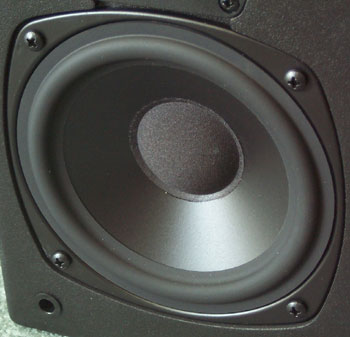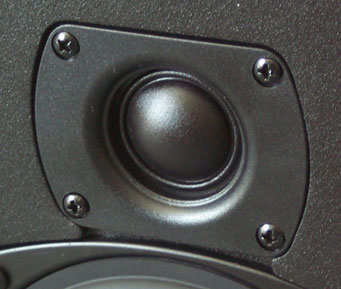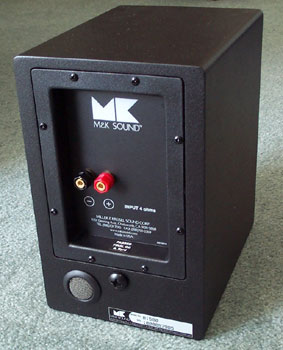It was CEDIA, September 2003.
Colin Miller and I were, as we usually are at these trade shows, hanging
around the M&K booth speculating how suspicious it would look if the two
of us were to pick up one of the 115 pound subs and make for the door. This time
around though, we were a tad dumbfounded: M&K were showing, front and center, a pair
of full range bookshelf speakers (or as full range as a bookshelf speaker
can be). That in and of itself was cause enough for question, coming
from a company which has made the subwoofer/satellite dogma something of a religion for
many of us. No, what had us floored is that these speakers were actually
ported, not sealed, a big change for M&K.M&K makes available to anyone who
cares to read it, an excellent paper labeled "M&K Sales Training Outline".
In it you will find more common sense than you can imagine. They spell out in very plain terms why they
(used to) exclusively make sealed speakers, contrasting that with the
inherent weaknesses of vented designs. So you can understand our
wonder at this new speaker which, at first glance, broke some of the company's
most fundamental statutes.
I leaned over to Colin and whispered, "Isn't
that one of the Seven Signs of the Apocalypse?"
We approached M&K's Chuck Back, the mover and shaker responsible for
issuing us our annual M&K review fix.
"What the #%$*?" I asked, with a nod towards the new
speakers.
Chuck instinctively knew the reason for my crass greeting, and in true
Chuck fashion, shrugged his shoulders and said, "Just
listen to them . . . ."
Before we continue, if you haven't already, it might be useful to reread
Colin Miller's excellent primer on the subject of sealed versus vented
speaker design:
How a Hole-in-the-Box Works - A Big Dig into Bass Reflex
It also would not be a bad idea to
check out what M&K has to say:
M&K Sales Training Outline (Adobe Acrobat PDF Viewer Required)
I will not bog down this review by
rehashing the content of the above material, except to say that M&K's
philosophy and advocacy of sealed enclosures still holds as true as
ever, for sub/sat compositions. In that scenario, porting is
not even an option for the satellite, and the subwoofer is such a
specialized bass transducer that you can design yourself away from ports and passive
radiators and into what many of us have discovered is the nirvana of sealed
subs.But as soon as you decide, for whatever
reason, that a sub cannot be part of the equation (space, cost, etc.),
venting the enclosure suddenly gets put back on the table as a potentially
advantageous way to go because you desperately need all the low end
extension you can get. Grabbing an extra octave is usually worth the
sheer cliff of a rolloff that follows.
 The B1500
The B1500
To crib a phrase for Amadeus, "On the surface it was simple
. . . almost
comic . . . ." With but a casual look at a B1500, one would not be overly impressed.
It has a 1" soft dome tweeter, a 5 1/4" poly woofer, and a port on the back.
I might have just described a hundred different speakers.
Go beyond the superficial and we start to appreciate that which I will
call "the M&K touch".
For starters, the box follows the same exquisite construction of all M&K
speakers: Incredibly solid MDF construction with rounded edges and a
unique finish. Being painted, it is continuous (without seams) yet is
in my estimation every bit as tough as a vinyl wrap. White and gray
are also available by the way.
The woofer is the same pedigree as found in the company's ultimate
satellite speakers.
In this modest B1500 speaker you are getting a piece of the performance
that companies such as Skywalker sound have invested in, namely tremendous power
handling with low dynamic compression. The only difference I can see
is that the basket is stamped steel, not the more rigid cast metal.
 The tweeter is also very reminiscent of M&K's statement piece standard.
In fact, it would seem the smaller front baffle is the only difference,
though a peek inside shows a slightly smaller magnet as compared to the
company's top shelf tweeter.
The tweeter is also very reminiscent of M&K's statement piece standard.
In fact, it would seem the smaller front baffle is the only difference,
though a peek inside shows a slightly smaller magnet as compared to the
company's top shelf tweeter.
M&Ks tells us they design the speaker and crossover taking into
account the output in all directions, not
just what you hear directly in front of it. They call this "Phase
Focused" crossover design. We at Secrets call it "doing it right". Like all decent speakers,
the B1500 should exhibit a smooth off axis response and a total power
response which is uncompromising. We'll talk more about how they
actually sound later.
M&K knows their market. Their greatest proponents are in the
professional world, where the MPS2510 (the pro version of the S150THX) is as
common as water. Glance through a collection of studios, post
production houses, etc., and you'll undoubtedly see the telltale cubes with
the distinctive 3-tweeter array. The B1500, and the slightly larger
B1600, therefore, are as simple as this:
They are M&K's essay at providing a small, near field monitor which do not
require a sub, yet embody that which we now expect from M&K.
Specifically, they have spectral neutrality, above average power handling, and
transient response which have not been sacrificed for the sake of the first
two.
 At the same time, and this is something M&K is particularly vocal about
(no pun intended), you can plug the port and turn the B1500
(or B1600) into a true sealed alignment satellite speaker. This in and
of itself is not revolutionary, as there have been several manufacturers
offering the same "plugability". The difference is that while others
offer it as more of a tuning feature where your decision to use the plug
is based on how much reinforcement the room is giving the speakers, with M&K
the whole port thing was implemented such that when closed off, the B1500
exhibits the specific 2nd order 80 Hz rolloff required for ideal splice with
the standard THX crossover (the combination of which M&K has always
advocated and used in their own external bass management boxes).
At the same time, and this is something M&K is particularly vocal about
(no pun intended), you can plug the port and turn the B1500
(or B1600) into a true sealed alignment satellite speaker. This in and
of itself is not revolutionary, as there have been several manufacturers
offering the same "plugability". The difference is that while others
offer it as more of a tuning feature where your decision to use the plug
is based on how much reinforcement the room is giving the speakers, with M&K
the whole port thing was implemented such that when closed off, the B1500
exhibits the specific 2nd order 80 Hz rolloff required for ideal splice with
the standard THX crossover (the combination of which M&K has always
advocated and used in their own external bass management boxes).
On the B1500 the ports are small. The smaller the port, the
shorter you need to make the length to get to a particular frequency of
tuning. However, you do have to worry more about turbulence at a given air
movement. Using larger ports,
aside from also requiring longer lengths that could make deep tuning a pain
in small cabinets, you also run into pipe resonance. Small ports are not as linear as large ones. Well,
to be fair, no ports are linear, but smaller ports are less linear. That is,
at higher output levels, they're more resistive, restricting airflow, so
that at really high output levels, they start looking more like a leaky
sealed system. This can actually work to be a pretty good thing in the case
of a speaker like the B1500 in that the
system can get the extension at average output levels to get the bass depth,
but start protecting itself when it gets a big hit instead of bottoming out
the driver. As for turbulence, the short answer is that with the port
on the back, its that much less of an issue in the first place.
The only thing I want to say about the port plug, other than the fact
that it functions as stated, is that once in, it is tricky to get out with
just your fingers. On my first attempt, despite a delicate and careful
manner, I nearly lost the plug inside the speaker. A pair of long
tweezers were needed to bring it out.
Going Beyond the Speaker
M&K's binding posts will take anything up to,
and including, a 4 gauge
wire. That is huge! I just put an 80 Amp (20,000 watt) electric furnace in my
home, and it required only one size larger than that (3 gauge).
 Integral to M&K's product line is a comprehensive and innovative "ST"
hardware system. Virtually all of their speakers have T-Nuts on the back,
giving you a metal threaded screw hole you can use to fasten any of the
various brackets without the pain of defacing your speakers with wood
screws.
Integral to M&K's product line is a comprehensive and innovative "ST"
hardware system. Virtually all of their speakers have T-Nuts on the back,
giving you a metal threaded screw hole you can use to fasten any of the
various brackets without the pain of defacing your speakers with wood
screws.
The ST hardware line includes wall and corner brackets, tilt swivel wall brackets,
but the coolest hardware are the 1/2" pipe pieces. You can buy an ST
tilt head, then buy standard 1/2" pipe the length you need, and couple that to
either a cast iron base, or table top receptacles. You can, for
example, mount your speakers to your desk, putting them at any height you
want, angled any way you want. Nice!
Listening
An insider at THX recently confessed to me that for the most part they
are unimpressed with the array of surround-for-music synthesis schemes which
are on the market (Pro Logic II, Logic 7, DTS Neo:6, Circle Surround, etc).
At the end of the day, when they go home to actually
enjoy some music, they do so over a good ol' two-channel system. Hmmm
. . . .
Getting two-channel "right" though is largely the speaker's responsibility,
or I should say the speaker/room combination. Get a speaker which is
designed specifically for on-axis response and you'll get a dull, uninteresting sound, flat as its
measured response may be.
Get a speaker which radiates sound any which way it can and
you'll end up with the opposite: a sound so busy you lose any sense of
positioning. Get it right, and put those "right" speakers in a room
with controlled acoustics, and muti-channel music can almost be ignored.
Back to that "Phase Focused" crossover, which as we said takes the total
response of the speaker in check, and given M&Ks "pro" heritage, tweaks it
for an acoustically sound room (no pun intended).
In my 007 theater, complete with its share of acoustical foam, the B1500
speakers delivered KILLER stereo sound!
Do not misunderstand here: The B1500s don't "need" a perfect
acoustic space. Rather, like any good speaker, they pay dividends when
placed in one. We tried the pair for a while as a set of PC speakers
in a room with decidedly "bad" acoustics and were delighted with the
results. They "work" fine with your face literally only a couple feet
from them, drowning out the mess of reflections within the room. But
back to the 007 . . . .
Coincident with the comments I've made on M&K speakers in the past, the
B1500s extol detail without being bright or brittle. They are
comfortable to listen to without coming across as laid back. You
cannot possibly find anything wrong with the midrange, as vocals, brass, and
cellos all come across as natural, neutral, and believable (competence of the
recording engineer permitting). In a word: True.
The B1500s are capable of "big" sound. The stage is defined and precise in positioning (something possible with any speaker only
when you are in the sweetest of sweet spots). Yet it transcends the
physical position of the speakers themselves. The B1500s image with
such accuracy that, seriously, at times I had to double check that Pro Logic
II was not engaged. My mind was telling me audio was coming from such
precise locations to the sides and behind, as well as the front center.
If you've ever read a speaker review which claimed prodigious, latent
bass from a 5.25" woofer bookshelf speaker, the author was full of
nonsense.
Yet some speaker designs do defy the logic of their cabinet's slight dimensions.
There was one in particular which I thought to have remarkable extension.
But at over $2000/pair, the name of that speaker shall be left unspoken, because the B1500
is unquestionably its equal, perhaps even its better, not only in quality
and quantity of bass, but all aspects of its sound. Yet again, proof
positive that in consumer A/V, price (unfortunately) cannot be taken for
granted as corresponding to what you get.
With the B1500s, we witnessed pretty much full output down to about 40 Hz with still very
much useable output at the claimed 35 Hz, enough to
deliver the emotion of Yo Yo Ma's Stradivarius, the impact of Neil Pert's
drums, and all the immediacy demanded of Sting's double bass. As
horrible as the mix is, Alanis Moriset did not sound as bad as usual, while
the B1500 realized all the pace and fervor of Dire Straits' excellent
audio engineering. Subjectively loud output seems to be no problem
whatsoever.
Of course, after a while, we plugged the ports, spliced them with my M&K MX-105 sealed subwoofer
(courtesy the THX crossover in my Onkyo), and as expected, the B1500s reaped
the benefit of extended dynamics, and inherited the latent, "goosebump bass"
of the 105. A stereo configuration to die for.
Conclusions
I would not hesitate to choose the B1500 for any near field role, be
it a mobile studio, modest console, or at the computer of anyone even
remotely serious about audio. In addition, I like the idea of
a home theater with five B1500s and one of the company's subs, making the B1500 a particularly
poignant choice for someone who wants to grow into 5.1. But all this
belies the larger point: M&K makes good speakers, end of story.
Pick whatever model fits your system and budget and start enjoying what most
are missing: The Sonic Truth of It.
- Brian Florian -
Equipment used during
this review:
Onkyo TX-SR800 THX Select Processor/Receiver
M&K MPS2510 THX PM3 Pro Monitors
Paradigm ADP-170 DiPole Surround Speakers
M&K MX-105 Powered Subwoofer
Rotel RB-985 5 Channel THX Power Amplifier
Yamaha DVD-V player
Yamaha Audio CD Player
Sony KV-27S36 TV


 The B1500
The B1500 The tweeter is also very reminiscent of M&K's statement piece standard.
In fact, it would seem the smaller front baffle is the only difference,
though a peek inside shows a slightly smaller magnet as compared to the
company's top shelf tweeter.
The tweeter is also very reminiscent of M&K's statement piece standard.
In fact, it would seem the smaller front baffle is the only difference,
though a peek inside shows a slightly smaller magnet as compared to the
company's top shelf tweeter. At the same time, and this is something M&K is particularly vocal about
(no pun intended), you can plug the port and turn the B1500
(or B1600) into a true sealed alignment satellite speaker. This in and
of itself is not revolutionary, as there have been several manufacturers
offering the same "plugability". The difference is that while others
offer it as more of a tuning feature where your decision to use the plug
is based on how much reinforcement the room is giving the speakers, with M&K
the whole port thing was implemented such that when closed off, the B1500
exhibits the specific 2nd order 80 Hz rolloff required for ideal splice with
the standard THX crossover (the combination of which M&K has always
advocated and used in their own external bass management boxes).
At the same time, and this is something M&K is particularly vocal about
(no pun intended), you can plug the port and turn the B1500
(or B1600) into a true sealed alignment satellite speaker. This in and
of itself is not revolutionary, as there have been several manufacturers
offering the same "plugability". The difference is that while others
offer it as more of a tuning feature where your decision to use the plug
is based on how much reinforcement the room is giving the speakers, with M&K
the whole port thing was implemented such that when closed off, the B1500
exhibits the specific 2nd order 80 Hz rolloff required for ideal splice with
the standard THX crossover (the combination of which M&K has always
advocated and used in their own external bass management boxes). Integral to M&K's product line is a comprehensive and innovative "ST"
hardware system. Virtually all of their speakers have T-Nuts on the back,
giving you a metal threaded screw hole you can use to fasten any of the
various brackets without the pain of defacing your speakers with wood
screws.
Integral to M&K's product line is a comprehensive and innovative "ST"
hardware system. Virtually all of their speakers have T-Nuts on the back,
giving you a metal threaded screw hole you can use to fasten any of the
various brackets without the pain of defacing your speakers with wood
screws.

